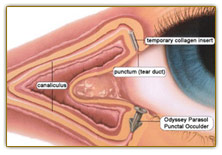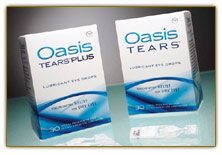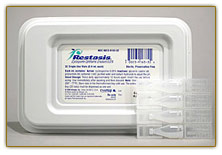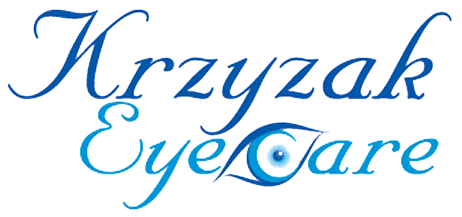Dry Eye Syndrome
Dry eye syndrome, also known as “keratitis sicca,” affects patients of all ages but tends to be more common as individuals get older. Natural aging processes result in a decrease in the volume of tears produced and a change in the quality of the tear film. Other causes of dry eye include:
- Pregnancy
- Menopause
- Use of certain medications (anti-histamines, anti-depressants, diuretics, sleeping pills, birth control pills, and various anti-acne medications among others)
- Contact lens wear
- Post-refractive eye surgery (LASIK, etc.)
- Environmental conditions (dry, windy, cold, and air pollution)
- Computer use and excessive close vision work (due to reduced blink rate)
- Chronic eyelid inflammation (blepharitis and meibomianitis)
- Systemic diseases (eg. Sjogren’s syndrome associated with rheumatoid arthritis, and Acne Rosacea)
Diagnosis and Treatment of Dry Eye Syndrome
 Your doctors at Krzyzak Eyecare will perform a variety of tests to diagnose dry eye based on your symptoms. Evaluation of tear function and dry eye is called lacrimal function analysis. A comprehensive dry eye related history will be taken to determine your level of symptoms, environmental conditions, general health history, and other factors relating to dry eye. The quality of your tear film is evaluated by observing the tears under a high powered microscope. Coloring dyes are used to determine the evaporation rate of your tears, damage to the surface cells of the cornea, and damage to the surface cells of the conjunctiva. Finally, the volume of tear production is measured by a test called “Zone Quick” or also known as the “Phenol Red Dye Thread Test”. In some cases a more sophisticated chemical analysis of your tear film can be performed as well.
Your doctors at Krzyzak Eyecare will perform a variety of tests to diagnose dry eye based on your symptoms. Evaluation of tear function and dry eye is called lacrimal function analysis. A comprehensive dry eye related history will be taken to determine your level of symptoms, environmental conditions, general health history, and other factors relating to dry eye. The quality of your tear film is evaluated by observing the tears under a high powered microscope. Coloring dyes are used to determine the evaporation rate of your tears, damage to the surface cells of the cornea, and damage to the surface cells of the conjunctiva. Finally, the volume of tear production is measured by a test called “Zone Quick” or also known as the “Phenol Red Dye Thread Test”. In some cases a more sophisticated chemical analysis of your tear film can be performed as well.
Tear Supplements
 An initial approach of dry eye therapy is the use of tear supplements. The idea is to add to your tear volume and to improve the quality of the tear film at the same time. Various tear supplements are available over the counter at pharmacies everywhere. New developments in tear supplements have been developed to match and complement the natural tear film. Some examples of excellent tear products on the market currently include:
An initial approach of dry eye therapy is the use of tear supplements. The idea is to add to your tear volume and to improve the quality of the tear film at the same time. Various tear supplements are available over the counter at pharmacies everywhere. New developments in tear supplements have been developed to match and complement the natural tear film. Some examples of excellent tear products on the market currently include:
- Systane Ultra drops (by Alcon)
- Optive (by Allergan)
- Blink tears (by AMO)
- Genteal tears (mild, moderate, and gel form by Novartis)
- Refresh with Omega (tears, Endura, liquigel, and Refresh PM ointment for night time by Allergan)
- Theratears
- Bion Tears
The various tear supplement formulations vary according to their formula. The individual brands come in various viscosities according to the severity of the dry eye and time of application (e.g. Gel or ointment use at bedtime). Many of the drops contain immediately-disappearing preservatives that are neutralized within a second after contacting the eye’s surface. This is very helpful for those with allergies or sensitivities to preservatives. Others are actually non-preserved and come in “unit dose” containers.
Tear Film Stablizers
 Research is showing us that many cases of dry eye are associated with deficiencies in the oil layer of the tear film. The oil layer is produced by sebaceous glands that are located within the upper and lower eyelids (called “meibomian glands”). Abnormalities of the oil layer of the tear film will result in rapid evaporation of the tears from the ocular surface. New agents have been developed that function to stabilize the tear film so that evaporation rates are significantly reduced. These agents will have extended duration of effect and as such are used less frequently during the day compared to tear supplements. Examples of tear film stabilizing agents used by the doctors at Krzyzak Eyecare are:
Research is showing us that many cases of dry eye are associated with deficiencies in the oil layer of the tear film. The oil layer is produced by sebaceous glands that are located within the upper and lower eyelids (called “meibomian glands”). Abnormalities of the oil layer of the tear film will result in rapid evaporation of the tears from the ocular surface. New agents have been developed that function to stabilize the tear film so that evaporation rates are significantly reduced. These agents will have extended duration of effect and as such are used less frequently during the day compared to tear supplements. Examples of tear film stabilizing agents used by the doctors at Krzyzak Eyecare are:
- Soothe XP (by Bausch & Lomb)
- Oasis Tears Plus (by Oasis Medical)
- Systane Balance (by Alcon)
- Retaine MGD (by Akorn)
Punctal Inserts
Tear supplements often only have a short duration of action and symptoms are not alleviated adequately for many patients with the use of tear drops only. A very effective method of treatment for these patients, especially if the dryness is due to low tear volume, is the use of Punctal Occlusion, or pluntal inserts or “plugs”. Tears naturally drain out of the eye via small openings located on the margins of the upper and lower lid towards the nose. These openings are called puncta. The punctum leads to drainage canals called canaliculi which then empty into the nasal passage and eventually into the throat.
Small semi-microscopic inserts known as punctum inserts or plugs are placed into the puncta in a way that is analogous to nose plugs. The plugs reduce the rate of drainage out of the eye so that the tear volume is increased. The plugs remain in place for extended periods of time exerting their effect in an ongoing way. There are a variety of types of plugs used. Some have a “cap” that positions flush with the margin of the eyelid. Others, like Medennium’s “Smart Plug,”position below the surface of the lid margin. New “extended duration” (“ED”) punctual inserts are made of naturally occurring collagen and can last for up to 6 months before melting away. These “ED” punctual inserts also remain below the surface of the lid margin. Many people experience very significant improvements in their symptoms following punctual occlusion. In rare cases there can be reasons to remove the plugs. The technique for plug removal is just as easy and painless as the insertion of the plugs and is completed in a mater of moments if necessary.
The fees associated with punctual occlusion therapy are typically covered under health insurance and Medicare as medically necessary. Krzyzak Eyecare will submit your claims directly to your insurance company or Medicare for you.
Medical Therapy for Dry Eye
 The next horizon for the treatment of dry eye involves the use of medications to stimulate tear production. The first such drug, Restasis (cyclosporine 0.05%) by Allergan pharmaceuticals, is FDA approved for the treatment of dry eye. This medication increases the tear volume by stimulating tear production. It is taken twice daily in eye drop form. An important thing to remember is that Restasis may take up to two months before results are noticed. It is taken as an ongoing therapy to continually maintain improved tear production. Once again, not all patients who suffer from dry eye will benefit from Restasis therapy. Your Krzyzak Eyecare doctor will be able to determine if you are a candidate during your eye examination and lacrimal function testing. A number of other new medications (both oral and topical) are currently being investigated for the treatment of dry eye. The general term for agents that stimulate tear production is secretagogues. Please check in at our web site regularly for updates on FDA approvals.
The next horizon for the treatment of dry eye involves the use of medications to stimulate tear production. The first such drug, Restasis (cyclosporine 0.05%) by Allergan pharmaceuticals, is FDA approved for the treatment of dry eye. This medication increases the tear volume by stimulating tear production. It is taken twice daily in eye drop form. An important thing to remember is that Restasis may take up to two months before results are noticed. It is taken as an ongoing therapy to continually maintain improved tear production. Once again, not all patients who suffer from dry eye will benefit from Restasis therapy. Your Krzyzak Eyecare doctor will be able to determine if you are a candidate during your eye examination and lacrimal function testing. A number of other new medications (both oral and topical) are currently being investigated for the treatment of dry eye. The general term for agents that stimulate tear production is secretagogues. Please check in at our web site regularly for updates on FDA approvals.
